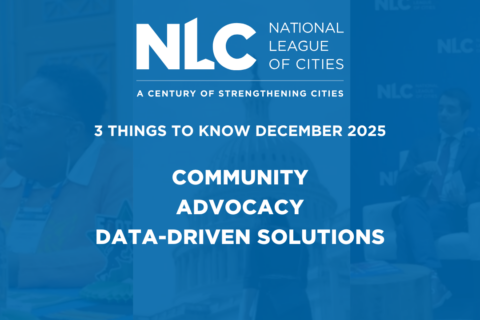On July 23, the White House released its AI Action Plan, developed in response to President Trump’s January executive order on AI. The Action Plan was informed by numerous public comments, including those filed by NLC (PDF). The Action Plan is organized around three central themes: accelerating innovation in AI, building infrastructure to support American progress in AI and positioning the United States as an international leader in AI diplomacy and security. While the AI Action Plan is not itself a regulatory action, it lays out a body of work for numerous federal agencies that will result in rule-making and changes to existing federal programs and processes.
These are some of the ways the AI Action Plan could impact local governments in the coming years:
1. The AI Action Plan Creates Potential for Reduced Preemption in Some Cases, and Increased Preemption in Others
The plan calls for a sweeping review of federal and state regulations and laws that could hinder AI innovation and adoption. This action could potentially ease regulatory burdens and unfunded mandates on localities but also presents the possibility of preemption. Specifically, the plan directs federal agencies to consider a state’s AI regulatory climate when making funding decisions and permits them to penalize states through limiting access to federal funds. This could impact local governments in impacted states. The plan also specifically directs the Federal Communications Commission to evaluate state AI regulations and whether they fall under the FCC’s “ability to carry out its obligations and authorities under the Communications Act of 1934.” In practice, these policy proposals could result in new preemptive regulations being promulgated that restrict local authority on the theoretical basis that state or local governance of AI prohibits or limits the provision of communications services.
2. The AI Action Plan Creates New Opportunities for Federal-Local Partnership Around the Workforce Impacts of AI
The plan addresses the workforce impact of AI, a key issue raised by NLC during the comment process. The plan calls for incorporation of AI skills development into existing federal education and workforce funding streams and programs; calls for the inclusion of AI skill development and training as a tax-advantaged employer benefit; directs the Bureau of Labor Statistics, the Census Bureau and the Bureau of Economic Analysis to analyze the impact of AI on the labor market; and directs federal resources towards rapid re-skilling and retraining for workers to mitigate the job-displacement impacts of AI on various industry sectors. The plan also calls for investment in the occupations that help support the infrastructure that runs AI, including electricians, HVAC technicians and other jobs through partnership with state and local workforce, school and career ante technical education stakeholders. The plan also would expand Registered Apprenticeships to include identified occupations critical to AI infrastructure.
3. The Plan’s Focus on Safety and Reliability of AI Systems Protects Local Governments as Users of AI
The plan includes a number of proposals that could improve the safety and reliability of AI systems on the market and improve the procurement process of AI systems for local governments. The plan calls for work on the development of standards in AI and performance and reliability metrics for AI systems, which could help local governments in doing due diligence on the tools they procure. The plan also includes proposals to speed federal agency AI adoption through the development of libraries of already-vetted tools and use cases for AI in government, which may assist local governments as well. The plan also addresses the safety of AI, both in promoting efforts to reduce the impact of malicious deepfakes and through improving the cybersecurity of the AI sector. These proposals may reduce the overall risk of AI tools on the market and ultimately the risk to local governments as end users.
4. The Plan Has Potentially Large-Scale Impacts on Environmental Review Processes
The plan impacts the environmental review process broadly, with a focus on speeding the construction of data centers to support the computing needs of AI systems. This includes proposals to create a new Categorical Exclusion under the National Environmental Policy Act (NEPA) for data centers and exemption of data centers from certain environmental reviews. The plan also directs agencies to review regulations covered by the Clean Air Act, Clean Water Act, Comprehensive Environmental Response, Compensation and Liability Act (CERCLA) and other laws for streamlining or reduction. In addition to regulatory streamlining, the plan proposes to expand efforts to use AI tools on the environmental review process itself, to accelerate and improve reviews.
5. The Plan Addresses the Impact of AI on Local Economies and Infrastructure
The plan could impact local and regional economies, particularly through its focus on advanced manufacturing and upgrades to the electrical grid. The plan calls for further federal investment in domestic manufacturing of advanced technologies, as well as the domestic manufacturing of critical components in the AI supply chain, like semiconductors and chips. The plan also calls for improvements to the nation’s electrical grid to account for the increased power demands of AI use and the need for stable, interconnected and resilient electricity generation and transmission.
AI Report and Toolkit
For more information on how AI is already being used by local governments and resources for exploring AI use in your own community, download NLC’s AI Report and Toolkit.










